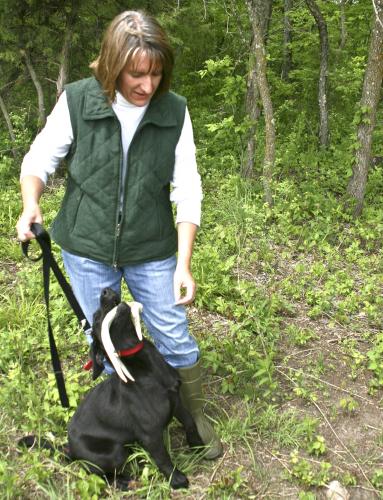
Xplor reconnects kids to nature and helps them find adventure in their own backyard. Free to residents of Missouri.


































Stay in Touch with MDC news, newsletters, events, and manage your subscription

Xplor reconnects kids to nature and helps them find adventure in their own backyard. Free to residents of Missouri.

A monthly publication about conservation in Missouri. Started in 1938, the printed magazine is free to residents of Missouri.


KANSAS CITY MO -- Mossy knew the quarry would remain motionless, so with nose to the ground the Labrador retriever crisscrossed among shrubs and trees in typical hunting dog style.
Suddenly the pup paused as his nose picked up a whiff of what he was searching for. But unlike many hunting situations, there was no downed duck to pick up or whir of wings as a pheasant flushed. Instead, Mossy picked up a single white-tail deer antler with his mouth and began a gleeful dash back toward trainer Carla Long. The five-month-old dog is well on the way to being a successful hunting companion for those who enjoy finding shed antlers.
“It’s really no different than training a bird dog,” said Long, who lives with husband Larry and family in the rural Siloam Springs area north of Albany in Gentry County. “I’m just instructing them to find the scent of deer antlers, and I do it when they’re at an early age.”
Male deer and elk shed their antlers in late winter and early spring and then start growing new ones. But for a few months after the antlers fall off they lay on the ground, until mice and rabbits seeking minerals chew them up.
Many people enjoy hunting for shed antlers in the woods and fields when the weather is cool and the landscape is open. Some hope to find trophy-sized antlers. Others use them for crafts such as knife handles or sculptures. Many shed antler hunters just enjoy the different shapes and sizes of their finds as natural art.
Antlers can be difficult to find though because they drop in brushy and grassy places. Deer will commonly lose one antler at a time. Seeing a brownish or whitish antler on the ground can be difficult and finding a matched pair even harder.
Dogs though, can smell antlers just like they can smell a quail or pheasant. A hard, bone-like antler may have almost no smell to a human. But a dog’s sense of smell is far keener.
Long trains Labrador pups to hone in on antler scent with their nose and then find and retrieve what once was atop a buck deer’s head.
“It’s what the dogs enjoy doing,” she said. “If they’re having fun doing it, that’s the thing.”
Long charges $4,000 for a Labrador she has trained to find shed antlers. She starts with registered pups from proven lineage with no health issues and gives them basic obedience skills so they also make good family pets. Owners take possession when the dog is six to seven months old and they continue the shed antler training that she started.
“The first year is a learning experience for the owner and the dog,” Long said.
Some owners use her shed antler dogs for double duty, such as for retrieving downed birds while waterfowl hunting. But she only provides the shed antler hunting training. For many of her customers, Long said, finding antlers is their main outdoor hobby.
“The dogs give them a better chance of finding and recovering antlers,” she said.
Long in past years trained dogs for game hunting. Then she noticed a few trainers around the nation offered dogs for sale that specialize in hunting shed antlers. So three years ago she began antler training with pups.
On her front porch is a pile of antlers found in past hunts that she uses for training. She leaves them out in the open air so they can become free of any human or dog scent. Long wears scent-blocking gloves when she’s handling antlers used for training. Once a dog has retrieved an antler a few times, it’s retired for a few weeks. She wants the dog to only hone in on antler scent.
When puppies arrive at her house, one of the first things they find is a pile of antlers in the yard. Puppies are allowed to play with antlers for a few hours after training sessions. Long does some toss and retrieve play with them, but she’s careful about not doing too much.
“Antlers don’t fly,” she said. “I want them to be looking for a motionless object and not looking for flight.”
Long has developed some techniques for conditioning pups to antler scent that she does not reveal. But the basics are tapping a dog’s instincts to hunt, to react to scent and to please the dog’s best friend _ the owner.
It’s probably possible that dogs could be trained to find morel mushrooms with the same technique, Long said, though she hasn’t tried that. Keeping a fragile morel fresh for training would be far harder than storing hard and dense antlers.
For now, Long and her pups are happy seeking antlers. Mossy takes such pride in finding an antler that his first impulse is to run back to the kennel and show off his finds for the other pups in training.
“Mossy is in heaven when he’s got an antler,” Long said. “He’s obsessed with the antler.”